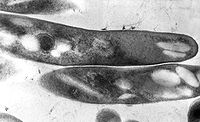
Droplet Digital PCR-Based Detection and Quantification of GyrA Thr-86-Ile Mutation Based Fluoroquinolone-Resistant Campylobacter jejuni
Sign Up to like & getrecommendations! Published in 2022 at "Microbiology Spectrum"
DOI: 10.1128/spectrum.02769-21
Abstract: Campylobacter jejuni is considered to be the leading cause of human bacterial gastroenteritis worldwide, and fluoroquinolones (FQs) are the main choices for the treatment of bacterial gastroenteritis in clinical practice. In theory, antimicrobial susceptibility testing… read more here.
Keywords: campylobacter jejuni; resistant jejuni; gyra; jejuni ... See more keywords

Characterization of DNA Gyrase Activity and Elucidation of the Impact of Amino Acid Substitution in GyrA on Fluoroquinolone Resistance in Mycobacterium avium
Sign Up to like & getrecommendations! Published in 2023 at "Microbiology Spectrum"
DOI: 10.1128/spectrum.05088-22
Abstract: The emergence of fluoroquinolone (FQ) resistance has further compounded the control of emerging Mycobacterium avium-associated nontuberculous mycobacteria infections worldwide. For M. avium, the association of FQ resistance and mutations in the quinolone resistance-determining region (QRDR)… read more here.
Keywords: mycobacterium avium; resistance; amino acid; gyra ... See more keywords

P859 Genotyping gyrA and penA from remnant neisseria gonorrhoeae positive cepheid xpert® clinical specimens
Sign Up to like & getrecommendations! Published in 2019 at "Sexually Transmitted Infections"
DOI: 10.1136/sextrans-2019-sti.901
Abstract: Background Neisseria gonorrhoeae (NG) has developed resistance to most antibiotics, making it increasingly difficult to treat. Molecular methods have been used to predict antimicrobial susceptibility based on the gyrA codon serine 91 and the mosaic… read more here.
Keywords: gyra; cepheid xpert; clinical specimens; neisseria gonorrhoeae ... See more keywords

High-resolution melting analysis of gyrA codon 84 and grlA codon 80 mutations conferring resistance to fluoroquinolones in Staphylococcus pseudintermedius isolates from canine clinical samples
Sign Up to like & getrecommendations! Published in 2017 at "Journal of Veterinary Diagnostic Investigation"
DOI: 10.1177/1040638717712330
Abstract: Staphylococcus pseudintermedius is an opportunistic pathogen of dogs and cats. A high-resolution melting analysis (HRMA) protocol was designed and tested on 42 clinical isolates with known fluoroquinolone (FQ) susceptibility and gyrA codon 84 and grlA… read more here.
Keywords: high resolution; gyra; resolution melting; resistance ... See more keywords